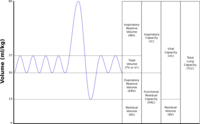
Photo from wikipedia
Monitoring of postoperative pulmonary function usually includes respiratory rate and oxygen saturation measurements. We hypothesized that changes in postoperative respiratory rate do not correlate with changes in tidal volume or… Click to show full abstract
Monitoring of postoperative pulmonary function usually includes respiratory rate and oxygen saturation measurements. We hypothesized that changes in postoperative respiratory rate do not correlate with changes in tidal volume or minute ventilation. In addition, we hypothesized that variability of minute ventilation and tidal volume is larger than variability of respiratory rate. Respiratory rate and changes in tidal volume and in minute ventilation were continuously measured in 27 patients during 24 h following elective abdominal surgery, using an impedance-based non-invasive respiratory volume monitor (ExSpiron, Respiratory Motion, Waltham, MA, US). Coefficients of variation were used as a measure for variability of respiratory rate, tidal volume and minute ventilation. Data of 38,149 measurements were analyzed. We found no correlation between respiratory rate and tidal volume or minute ventilation (r2 = 0.02 and 0.01). Mean respiratory rate increased within the first 24 h after abdominal surgery from 13.9 ± 2.5 to 16.2 ± 2.4 breaths/min (p = 0.008), while tidal volume and minute ventilation remained unchanged (p = 0.90 and p = 0.18). Of interest, variability of respiratory rate (0.21 ± 0.06) was significantly smaller than variability of tidal volume (0.37 ± 0.12, p < 0.001) and minute ventilation (0.41 ± 0.12, p < 0.001). Changes in postoperative respiratory rate do not allow conclusions about changes in tidal volume or minute ventilation. We suggest that postoperative alveolar hypoventilation may not be recognized by monitoring respiratory rate alone. Variability of respiratory rate is smaller than variability in tidal volume and minute ventilation, suggesting that adaptations of alveolar ventilation to metabolic needs may be predominately achieved by variations in tidal volume.
Journal Title: Journal of Clinical Monitoring and Computing
Year Published: 2020
Link to full text (if available)
Share on Social Media: Sign Up to like & get
recommendations!